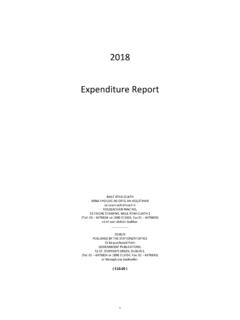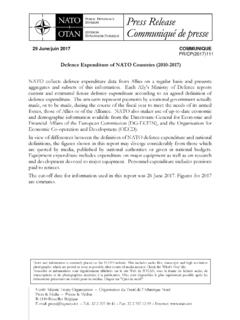Transcription of Consumer Expenditures - 2017
1 For release: 10:00 (EDT), Tuesday, August 29, 2017 USDL-17-1175 Technical Information: (202) 691-6900 Media Contact: (202) 691-5902 Consumer Expenditures 2016 Average Expenditures per Consumer unit1 for 2016 were $57,311, a increase from 2015 levels, the Bureau of Labor Statistics reported today. During the same period, the Consumer Price Index (CPI-U) rose percent2, and average pre-tax income per Consumer unit increased percent to $74,664. In 2015, spending increased percent from 2014 levels. Six of the eight major components of household spending increased in 2016, as show n in table A. Of these, cash contributions Expenditures showed the greatest percentage increase, percent. This was followed by Expenditures for personal insurance and pensions, rising percent, healthcare, rising percent, food and housing, both rising percent, and entertainment, rising percent.
2 Expenditures on transportation fell percent, while Expenditures on apparel and services fell percent. Spe nding patte rns by se le cte d compone nt Expenditures on cash contributions rose again this year, up percent after rising percent in 2015. Personal insurance and pensions Expenditures rose percent to $6,831. This was primarily driven by the increase in pensions and Social Security Expenditures . The non-payroll deposits in retirement plans subcomponent was up over 26 percent in 2016 and up over 83 percent since 2014. The subcomponent life and other personal insurance fell percent. Healthcare Expenditures rose percent. This was primarily driven by increased health insurance Expenditures , up percent. Housing Expenditures increased percent.
3 The largest subcomponent, shelter, rose percent. The change w as driven by rented dwellings, up percent. Owned dwellings, which includes mortgage interest, property taxes, and maintenance, repairs, and insurance increased percent. 1 Consumer units include families, single persons living alone or sharing a household with others but who ar e financially independent, or two or more persons living together who share expenses. 2 This is calculated as the percentage change between the annual average CPI-U for all items for 2016 ( ) and the annual average CPI-U for all items for 2015 ( ). See CPI Detailed Report, Data for January 2017, Table 24. Expenditures on the discretionary categories of food away from home and entertainment continued increasing in 2016, up percent and percent respectively, after increasing percent and percent in 2015.
4 Transportation Expenditures fell percent primarily driven by the decline in vehicle purchases Expenditures and the decline in gasoline and motor oil Expenditures . Gasoline and motor oil Expenditures have declined each year since 2012. The second largest subcomponent of transportation, other vehicle expenses, which includes finance charges, maintenance, insurance, and rentals/leases/licenses, rose percent. Table A. Ave rage e xpe nditure s and income of all consume r units and pe rce nt change s for selected components, 2014-161 Ite m 2014 2015 2016 Percent change 2014 - 2015 2015 - 2016 Average income before $66,877 $69,629 $74,664 Average annual 53,495 55,978 57,311 6,759 7,023 7, 203 Food at 3,971 4,015 4, 049 Food away from 2,787 3,008 3, 154 17,798 18,409 18,886 10,491 10,742 11,128 Owned 6,149 6,210 6,295 Rented 3,631 3,802 4,035 Apparel and 1,786 1,846 1, 803 9,073 9,503 9, 049 Vehicle 3,301 3,997 3, 634 Gasoline and motor 2,468 2,090 1, 909 Other vehicle 2,723 2,756 2,884 4,290 4,342 4, 612 Health 2,868 2,977 3.
5 160 2,728 2,842 2, 913 Cash 1,788 1,819 2, 081 Personal insurance and 5,726 6,349 6, 831 Life and other personal 327 333 322 Pensions and Social 5,399 6,016 6, 509 All other 3,547 3,845 3,933 1 Subcategories do not sum to 100%. Spe nding by composition of consume r unit Consumer expenditure Survey (CE) data measure how consumers allocate their spending among the various components of average annual Expenditures . Table B and chart 1 compare the shares allocated to selected major expenditure categories by composition of Consumer unit in 2016. One parent Consumer units with at least one child under 18 allocated over one-half of their total spending to food and housing, increasing their share for both categories from 2015 and reported the highest shares of spending on food and housing among the groups studied.
6 Over 10 percent of total spending for married couple only Consumer units went to healthcare, over twice as large a share as reported by one parent Consumer units ( percent). Married couple w ith children Consumer units allocated the highest share of all groups to personal insurance and pensions ( percent), while other married couple Consumer units (those w ith married couples and persons other than children living in the Consumer unit) allocated the highest share to transportation ( percent). Table B. Shares of average annual Expenditures on selected major components by composition of Consumer unit, 2016 Ite m Married couple only Married couple with children Other married couple Consumer units One parent, at least one child under 18 Single person and other Consumer units Food Housing Transportation Healthcare Personal insurance and pensions Chart 1.
7 Shares of average annual Expenditures on selected major compone nts by composition of Consumer unit, 2016 010203040 FoodHousingTransportationHealthcarePerso nal insurance andpensionsPercentMarried couple onlyMarried couple with childrenOther married couple Consumer unitsOne parent, at least one child under 18 Single person and other Consumer units Spe nding by income quintile Table C and Chart 2 show the percent change for Expenditures by income quintile. Overall spending increased in all five quintiles, ranging from percent in the highest quintile to percent in the second quintile. Healthcare, personal insurance and pensions, food away from ho me, and housing Expenditures increased across all income quintiles. Spending on food at home, apparel and services, and entertainment saw increases in three of five quintiles.
8 C ash contributions had increases in two of five quintiles. Transportation Expenditures increased by percent and percent for the lowest and second quintiles, but declined between percent and percent for the highest three quintiles. Table C. Dollar change and percent change in average annual Expenditures on major compone nts by income quintile , 2015-16 Item Lowest Second Thi r d Fourth Highest Dollar Percent Dollar Percent Dollar Percent Dollar Percent Dollar Percent Average annual expenditure change: $668 $1,707 $1,752 $1,239 $1,713 95 -44 425 271 163 At 3 -158 252 193 -117 Away from 92 115 172 78 280 377 720 506 279 626 Apparel and 84 25 217 -25 -514 208 69 -356 -399 -1,719 226 105 301 114 628 -124 45 126 358 -31 Cash -154 377 -34 1 1,144 Personal insurance and 53 26 247 595 1,603 All other -97 385 321 45 -189 Chart 2.
9 Percent change in average annual Expenditures by income quintile, 2015-16 0123456 LowestSec ondThirdFourthHi ghestPercent Other available data Consumer expenditure (CE) data include the Expenditures and income of consumers, as well as the demographic characteristics of those consumers. Tables with more expenditure detail are available at Published tables provide 2016 CE data by standard classifications that include income quintile, income decile, income class, age of reference person, size of Consumer unit, number of earners, composition of Consumer unit, region of residence, housing tenure, type of area (urban-rural), race, Hispanic origin, occupation, and highest education level of any member. A generational table, published as an experimental table since 2014, is being added as a new standard table this year.
10 It uses the birth year of the reference person to categorize Consumer units into five generational categories defined by the Pew Research Center. These annual tables include means, shares, and standard errors. Other tables available on the website include Expenditures by age, region, size, or gender cross-tabulated by income before taxes and other demographic variables. Historical tables back to 1984 and selected metropolitan area tabulations are also available. Future articles in the BLS Beyond the Numbers publication series w ill highlight recent trends in prices and spending in the economy, and will feature 2016 CE data. Recent CE-specific Beyond the Numbers articles provide analyses of topical economic issues and long term spending trends, as well as comparisons of CE data to other data series (see ).














